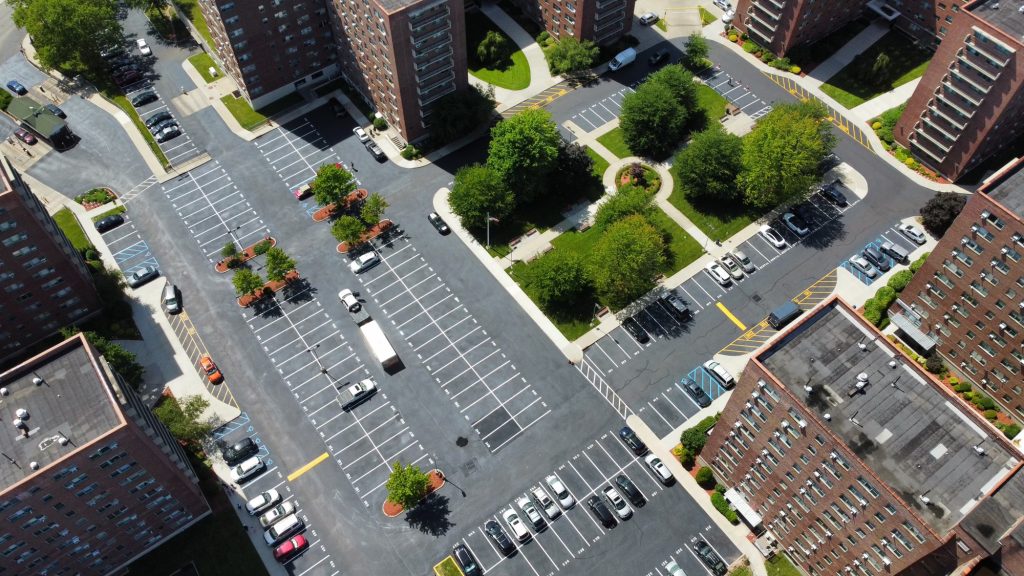
Table of Contents
How Often Does A Parking Lot Need Sealcoating And Crack Repairs?
Sealcoating, and crack repairs can add many years to the useful life of your asphalt pavement. You may ask yourself, how often does a parking lot need sealcoating and crack repairs? Procedures are important, but there’s no set schedule for how often to do them.
A contractor can suggest a maintenance schedule for your pavement, based on its condition and needs. In this blog post, we will discuss key considerations that determine how often does a parking lot need sealcoating and crack repairs.
Our Latest Sealcoat and Crack Repair:
When is The Appropriate Time to Fix Cracks in Asphalt Parking Lots?
Cracks endanger the health of your asphalt pavement, so it is best to have them repaired as soon as they appear. Water that enters the cracks can freeze, worsening existing cracks and spawning additional cracks. When water reaches the base of the pavement, it can erode and destabilize the supporting foundation. The pavement may develop cracks that look like alligator skin and potholes, which can weaken its overall structure.
Regular parking lot inspections by a contractor can quickly address major cracks. Annual inspections for parking lots less than five years old are sufficient unless there is visible pavement damage.
Have your contractor check your parking lot for cracks every spring and fall to keep it in good condition. Regardless of the pavement’s age, you should also have cracks repaired before your contractor applies sealcoating.
The Coolest Crack – Seal – Strip:
Factors Influencing Crack Repair Frequency:
- Crack Size and Type: Small hairline cracks in a surface, might not need attention right away. But if the cracks are bigger, it’s important to fix them quickly so they don’t get worse.
- Location: Cracks at the edges of a parking lot or those near drainage areas are more susceptible to water penetration. It is advisable to address these cracks promptly to avoid water seeping beneath the pavement’s base.
- Weather Exposure: Parking lots in regions with frequent freeze-thaw cycles are more prone to crack formation. Regular crack repairs can prevent water from seeping into cracks, freezing, and causing them to expand.
How Often Does an Asphalt Parking Lot Require Sealcoating?
A new asphalt pavement should not have sealcoating applied until the asphalt has cured, which normally takes at least three months. However, you should not wait more than a year to have your contractor perform the initial sealcoating.
Factors that determine your schedule include pavement condition, lot capacity, and permitted vehicle types.ypes of vehicles you permit. An average parking lot needs fresh sealcoating every two years.
Different parking lots require sealcoating at varying frequencies, with some only needing it every few years. Areas with high car traffic require more frequent touch-ups. Consider sealcoating if your pavement color changes. The same is true if your existing sealcoating is flaking off, rippling, or turning to dust.
Factors Influencing Sealcoating Frequency:
- Traffic Volume: High traffic areas, such as commercial parking lots, experience more wear and tear. As a result, they might require more frequent sealcoating to maintain their integrity.
- Climate Conditions: Extreme weather conditions, such as harsh winters or intense sunlight, can accelerate pavement worsening. Parking lots in regions with significant temperature fluctuations may need more frequent sealcoating to counteract these effects.
- Age of Pavement: Newer pavements typically have more inherent strength and flexibility. However, as pavement ages, its binder (bitumen) can degrade, leading to increased stress. Older parking lots might need more frequent sealcoating.
- Usage Patterns: Lots used for heavy-duty purposes, such as truck terminals or industrial areas, will experience greater stress and strain. These areas might need sealcoating more often compared to lighter traffic zones.
Recommended Maintenance Schedule:
- 1st Sealcoat After New Asphalt Installation: 1 Summer Cycle
- Sealcoat after 1st: Every 2 to 3 years
- Crack Repairs: Annually or as needed
Extra Tip: How Often Does a Parking Lot Need New Striping?
If visibility drops by more than 25%, replace parking lot markings for safety, compliance, and aesthetics.
Conclusion:
Maintaining your parking lot with sealcoating and crack repairs can extend its life, save money on repairs, and improve your property’s appearance. Consider traffic, climate, usage, and pavement age when creating a maintenance schedule for your parking lot. Remember, investing in preventative maintenance today can save you from costly repairs tomorrow.
Contact Royal Pavement Solutions for Help
Royal Pavement Solutions offers sealcoating, asphalt repairs, parking lot line striping, asphalt paving, crack sealing, asphalt milling, concrete services, and site work. We have the staffing, equipment, and expertise to consistently deliver exceptional results. Our goal is to exceed your expectations and earn your loyalty. Contact us for a free quote by either submitting the online form or calling 844-777-7924.


Comments are closed.